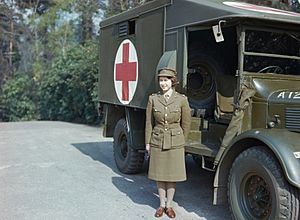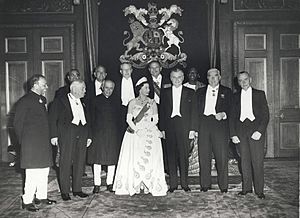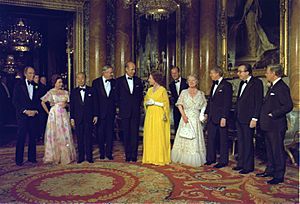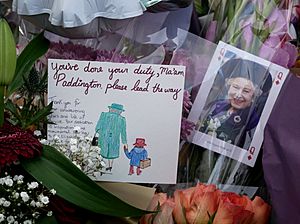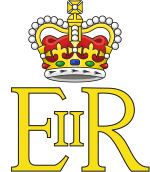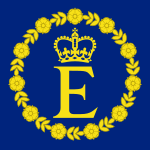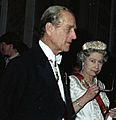Elizabeth II facts for kids
Quick facts for kids Elizabeth II |
|||||||||||||||||||||||||||||||||||||||||||||||||||||||||||||||
|---|---|---|---|---|---|---|---|---|---|---|---|---|---|---|---|---|---|---|---|---|---|---|---|---|---|---|---|---|---|---|---|---|---|---|---|---|---|---|---|---|---|---|---|---|---|---|---|---|---|---|---|---|---|---|---|---|---|---|---|---|---|---|---|
| Head of the Commonwealth | |||||||||||||||||||||||||||||||||||||||||||||||||||||||||||||||
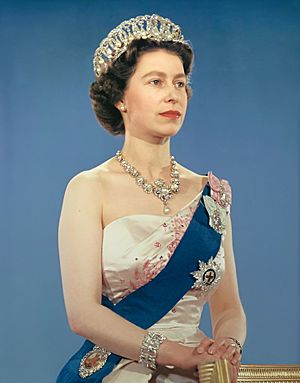
Official portrait, 1959
|
|||||||||||||||||||||||||||||||||||||||||||||||||||||||||||||||
| Queen of the United Kingdom
and other Commonwealth realms
|
|||||||||||||||||||||||||||||||||||||||||||||||||||||||||||||||
| Reign | 6 February 1952 – 8 September 2022 | ||||||||||||||||||||||||||||||||||||||||||||||||||||||||||||||
| Coronation | 2 June 1953 | ||||||||||||||||||||||||||||||||||||||||||||||||||||||||||||||
| Predecessor | George VI | ||||||||||||||||||||||||||||||||||||||||||||||||||||||||||||||
| Successor | Charles III | ||||||||||||||||||||||||||||||||||||||||||||||||||||||||||||||
| Born | Princess Elizabeth of York 21 April 1926 Mayfair, London, United Kingdom |
||||||||||||||||||||||||||||||||||||||||||||||||||||||||||||||
| Died | 8 September 2022 (aged 96) Balmoral Castle, Aberdeenshire, Scotland, United Kingdom |
||||||||||||||||||||||||||||||||||||||||||||||||||||||||||||||
| Burial | 19 September 2022 King George VI Memorial Chapel, St George's Chapel, Windsor Castle |
||||||||||||||||||||||||||||||||||||||||||||||||||||||||||||||
| Spouse | |||||||||||||||||||||||||||||||||||||||||||||||||||||||||||||||
| Issue Detail |
|||||||||||||||||||||||||||||||||||||||||||||||||||||||||||||||
|
|||||||||||||||||||||||||||||||||||||||||||||||||||||||||||||||
| House | Windsor | ||||||||||||||||||||||||||||||||||||||||||||||||||||||||||||||
| Father | George VI | ||||||||||||||||||||||||||||||||||||||||||||||||||||||||||||||
| Mother | Elizabeth Bowes-Lyon | ||||||||||||||||||||||||||||||||||||||||||||||||||||||||||||||
| Signature | |||||||||||||||||||||||||||||||||||||||||||||||||||||||||||||||
Elizabeth II (born Elizabeth Alexandra Mary; 21 April 1926 – 8 September 2022) was the Queen of the United Kingdom and many other countries from 1952 until her death in 2022. She reigned for 70 years and 214 days. This was the longest reign of any British monarch ever. It was also the longest reign for any female head of state in history.
Elizabeth became Queen when she was 25 years old. During her time as Queen, many big changes happened. These included the independence of many African countries and the UK joining and then leaving the European Union. The number of countries she was Queen of changed over time. This happened as some territories became independent or became republics.
Throughout her life, many people in the UK supported the monarchy. Elizabeth herself was very popular. She passed away at the age of 96 at Balmoral Castle in Scotland. Her oldest son, Charles III, became King after her.
Contents
Early Life and Family
Elizabeth was born on 21 April 1926. Her father was the Duke of York, who later became King George VI. Her mother was the Duchess of York, who later became Queen Elizabeth The Queen Mother.
Her close family called her "Lilibet." She was very loved by her grandfather, King George V. She called him "Grandpa England."
Elizabeth had one younger sister, Princess Margaret, born in 1930. Both princesses were taught at home. Their lessons focused on history, languages, literature, and music.
Becoming Heir to the Throne
When her grandfather, King George V, was still alive, Elizabeth was third in line to the throne. Her uncle, Edward, and her father were ahead of her. Most people did not expect her to become Queen. This was because Edward was young and expected to marry and have children.
But when her grandfather died in 1936, her uncle Edward became King. This made Elizabeth second in line. Later that year, Edward decided to give up the throne. He wanted to marry a divorced woman named Wallis Simpson, which caused a big problem.
Because of this, Elizabeth's father became King George VI. Since Elizabeth had no brothers, she became the next in line to the throne.
Elizabeth had private lessons in history from a teacher at Eton College. She also learned French from teachers who spoke it as their first language. A special Girl Guides group was even started for her. This allowed her to meet and spend time with other girls her age. She later joined the Sea Rangers.
Elizabeth During World War II
In September 1939, Britain entered the Second World War. Some people suggested that Princesses Elizabeth and Margaret should go to Canada. This would keep them safe from the bombings in London. But their mother refused, saying, "The children won't go without me. I won't leave without the King. And the King will never leave."
The princesses stayed at Balmoral Castle in Scotland for a while. Then they moved to Sandringham House. For most of the war, they lived safely at Windsor Castle.
In 1947, Princess Elizabeth went on her first trip outside the UK. She traveled through southern Africa with her parents. On her 21st birthday, she made a famous promise. She said, "I declare before you all that my whole life... shall be devoted to your service."
Marriage and Children
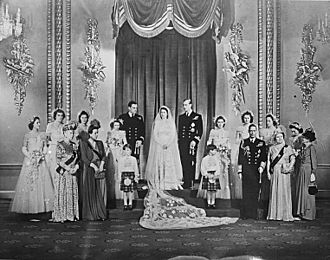
Elizabeth first met Prince Philip of Greece and Denmark in 1934. They met again in 1937 and a third time in 1939. Even though Elizabeth was only 13, she said she fell in love with Philip. They started writing letters to each other. Their engagement was announced on 9 July 1947.
Before they married, Philip gave up his Greek and Danish titles. He also changed his religion to Anglicanism. He took the name Philip Mountbatten. Just before the wedding, he was made the Duke of Edinburgh.
Elizabeth and Philip were married on 20 November 1947 at Westminster Abbey. They received 2,500 wedding gifts from all over the world.
Their first child, Prince Charles, was born on 14 November 1948. Their second child, Princess Anne, was born on 15 August 1950.
For a few years, Philip was a Royal Navy officer in Malta. He and Elizabeth lived there for several months at a time. Their two children stayed in Britain.
Elizabeth gave birth to her third child, Prince Andrew, on 19 February 1960. Her fourth child, Prince Edward, was born on 10 March 1964.
Her Reign as Queen
Becoming Queen
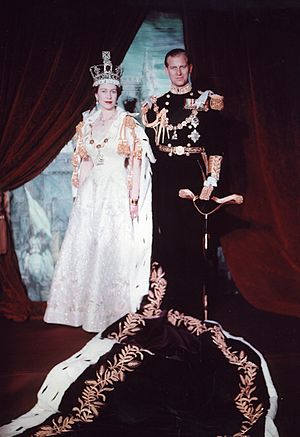
King George VI's health got worse in 1951. Elizabeth often took his place at public events.
In early 1952, Elizabeth and Philip went on a tour of Australia and New Zealand. They stopped in Kenya first. On 6 February 1952, they were in Kenya when they heard the news. King George VI had died. This meant Elizabeth was now Queen. Philip told her the sad news. She decided to keep Elizabeth as her royal name.
She was announced as Queen in all her countries. The royal group quickly returned to the United Kingdom. Elizabeth and Philip then moved into Buckingham Palace.
When Elizabeth became Queen, some thought the royal family's name might change. It was common for a wife to take her husband's last name. Philip suggested "House of Edinburgh." But the British Prime Minister, Winston Churchill, and Elizabeth's grandmother, Queen Mary, wanted to keep the name House of Windsor. So, Elizabeth announced that "Windsor" would remain the royal family's name.
Her coronation ceremony took place at Westminster Abbey. For the first time, parts of it were shown on television. Elizabeth asked for her coronation dress to have flowers from all the Commonwealth countries sewn onto it.
The Commonwealth and Royal Tours
During Elizabeth's life, the British Empire changed into the Commonwealth of Nations. By the time she became Queen in 1952, she was already the head of many independent countries. In 1953, the Queen and Philip went on a seven-month trip around the world. They visited 13 countries. She was the first reigning monarch of Australia and New Zealand to visit those nations. Huge crowds came to see her. It's thought that three-quarters of Australia's population saw her during her visit.
Throughout her reign, the Queen made hundreds of state visits and Commonwealth tours. She was the most traveled head of state in the world.
The Queen also started new traditions. Her first "royal walkabout" happened during a tour in Australia and New Zealand in 1970. This was when she walked among ordinary people to meet them.
Royal Jubilees
In 1977, Elizabeth celebrated her Silver Jubilee. This marked 25 years since she became Queen. Parties and events took place across the Commonwealth. These celebrations showed how popular the Queen was.
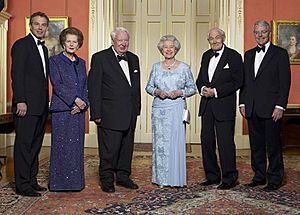
In 2002, the Queen celebrated her Golden Jubilee, marking 50 years on the throne. Like in 1977, there were street parties and special events. Many monuments were named to honor the occasion. One million people came to the main Jubilee celebration in London each day.
Her Diamond Jubilee in 2012 marked 60 years as Queen. Celebrations were held in all her countries. She and Philip toured the UK. Her children and grandchildren visited other Commonwealth countries for her. On 4 June, Jubilee beacons were lit around the world.
The Queen opened the 1976 Summer Olympics in Montreal. She also opened the 2012 Summer Olympics and Paralympics in London. This made her the first head of state to open two Olympic Games in two different countries. For the London Olympics, she even acted in a short film. She played herself alongside Daniel Craig as James Bond.
On 9 September 2015, she became the longest-reigning British monarch. She passed her great-great-grandmother, Queen Victoria. On 6 February 2017, she celebrated her Sapphire Jubilee, marking 65 years on the throne.
COVID-19 Pandemic and Platinum Jubilee
In March 2020, during the COVID-19 pandemic, the Queen moved to Windsor Castle. She stayed there to be safe. Public events were canceled. She received her COVID-19 vaccinations in 2021.
Prince Philip, her husband, died on 9 April 2021. They had been married for 73 years. This made Elizabeth the first British monarch to reign as a widow since Queen Victoria. Due to COVID-19 rules, the Queen sat alone at Philip's funeral. This made many people around the world feel sad for her.
The Queen's Platinum Jubilee began on 6 February 2022. This marked 70 years since she became Queen. In her message for the day, she promised again to serve the public her whole life.
During the Platinum Jubilee celebrations, the Queen mostly appeared on the balcony. She missed the special church service. For the Jubilee concert, she even took part in a fun sketch with Paddington Bear. On 13 June 2022, she became the second-longest reigning monarch in history.
Death
On 8 September 2022, Buckingham Palace announced that doctors were concerned about Elizabeth's health. She was at Balmoral Castle. Her four children and some grandchildren traveled to be with her. Her death was confirmed that evening.
Her funeral was held at Westminster Abbey on 19 September 2022. She was buried at the King George VI Memorial Chapel, which is part of St George's Chapel at Windsor Castle.
Beliefs and Interests
Elizabeth rarely gave interviews. Not much was known about her personal feelings. She did not share her political opinions in public.
Elizabeth felt a strong sense of duty to her religion and country. She took her Coronation Oath very seriously. She was the Supreme Governor of the Church of England. She also worshipped with the Church of Scotland.
Elizabeth was a patron of over 600 organizations and charities. It is estimated that she helped raise over £1.4 billion for these groups during her reign. Her main hobbies included horse riding and dogs. She especially loved her Pembroke Welsh Corgis.
Interesting Facts About Elizabeth II
- She was named Elizabeth after her mother. Alexandra was after her great-grandmother. Mary was after her grandmother.
- In 1940, at age 14, Elizabeth made her first radio broadcast. It was during the BBC's Children's Hour. She spoke to other children who had been moved from cities during the war.
- Her lifelong love of corgis started in 1933. Dookie was the first corgi her family owned.
- The first official photo of Elizabeth was taken in 1926.
- Elizabeth needed ration coupons to buy fabric for her wedding dress. Britain was still recovering from the war.
- In October 1994, she was the first reigning British monarch to visit Russia.
- A team of five dressers, a dressmaker, and a hat maker managed her clothes.
- In 2020, her personal wealth was estimated at £350 million.
- As of 2021, she was the third most admired woman in the world. She appeared in the top ten more than any other woman in the poll's history.
Elizabeth II Quotes
- "It's all to do with the training: you can do a lot if you're properly trained."
- "Let us not take ourselves too seriously. None of us has a monopoly on wisdom."
- "It has perhaps always been the case that the waging of peace is the hardest form of leadership of all."
- "Good memories are our second chance at happiness."
- "I know of no single formula for success. But over the years I have observed that some attributes of leadership are universal and are often about finding ways of encouraging people to combine their efforts, their talents, their insights, their enthusiasm and their inspiration to work together."
- "Work is the rent you pay for the room you occupy on earth."
Titles and Symbols
Elizabeth had many titles and honorary military roles across the Commonwealth. She was also the head of many royal orders in her own countries. She received honors and awards from around the world. In each of her countries, she had a special title. For example, in Saint Lucia, she was "Queen of Saint Lucia and of Her other Realms and Territories."
When speaking to the Queen, people would first say Your Majesty. After that, they would say Ma'am (pronounced like "jam").
Elizabeth also had special royal flags and personal flags. These were used in the United Kingdom, Canada, Australia, New Zealand, Jamaica, and other places.
Images for kids
-
Riding at Windsor with President Reagan, June 1982
-
Riding Burmese at the 1986 Trooping the Colour ceremony
-
Elizabeth (far left) on the balcony of Buckingham Palace with her family and Winston Churchill on 8 May 1945
-
On the cover of Time magazine, April 1929
-
In Queensland, Australia, 1970
See also
 In Spanish: Isabel II del Reino Unido para niños
In Spanish: Isabel II del Reino Unido para niños


